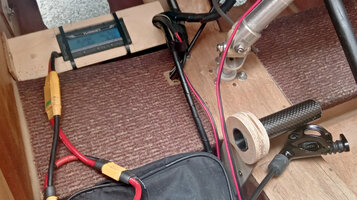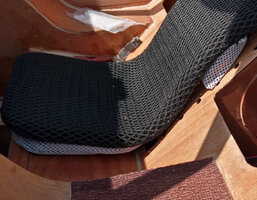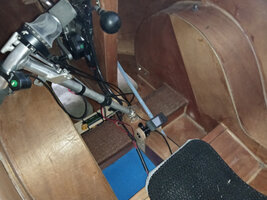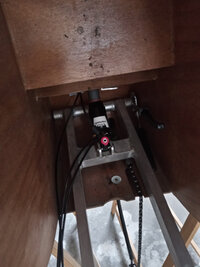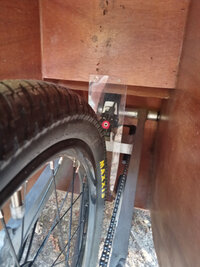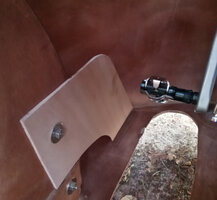Time for another workshop report, mostly for current and future builders.
As you all know I did some very serious crash testing to see just how strong the Agilo is

The result was one bent axle, 2 bent wishbones and because of the state of the track my 2 Gocycle tyres did not do much over 300 km... The body is very strong! The French Basque Country has some of the most dangerous speed bumps you will ever see anywhere. To be approached with caution.
On the front there are now Conti Contact Urban in 50-406, half the price of the Gocycle. The wishbone situation is still being dealt with, I made a pair from high tensile 6 mm steel threaded rod and added 8x1 mm aluminium tube over the top. Not stiff enough... For the moment the VM.nl ones are back in but rotated 180º so the thread that was bent then straightened is now inboard. I still think that high tensile steel is a much better idea than thread welded to 10 mm stainless tube and I have found a source for 10 mm x 2 mm carbon fibre tube. I can now remove and install the front suspension with my eyes closed. I really need to find a better method of setting the track than inexperienced helpers. Or an 80 kg person to sit in the seat while I do the measuring...
This is a very disappointing situation because exactly one year ago today Bodo Sitko stopped for a visit and the track was perfect.
In my order to Ginkgo were new PTFE chain tubes. The original slack side tube was too short and I managed to send the drive side one around the chainring when it broke free

. Builders, I recommend PTFE because you can see if the chain has a twist in it. It is also as slippery as heck and so it makes a lot less noise, just testing on the trestles in the workshop things are much smoother. Threading 3 lengths of bicycle chain through an almost totally enclosed drive train is a real mission. I have installed the chain tensioning bungee cord system from the plan at the front thanks to the longer chain tube. This is all you need if you are using a single chainring on the front, it is perfect for absorbing suspension movement. With 2 x chainrings and 14T difference between the 42T and 56T the derailleur/tensioner at the back was not enough to keep the slack side tight enough - I had chain slap and an occasional jump at the rear, especially when using the 42T. Now the front shifts much better and we will see on the first garden run if the chain slap problem is solved.
I removed the plastic 13T Alligt idler pulley from my trike parts box and replaced it with the 16T aluminium Ginkgo one. A small criticism
@Lutz/Co, the cable ties provided are nice and thin but two of them slipped, not a good idea... So builders just use some better narrow cable ties from your parts box that grip and don't come loose. Holding both idler pulleys in your hands you feel the build quality of the Ginkgo pulley oozing through your fingers

Returning to the workshop earlier in the week I got to try suspension lockout again and... Everyone seated? Managed 24 km/h up a >6% street in assist level 5 running 42:16 and 11th direct drive gear. I even had to slow my cadence to stay at 24 km/h. So I think we can safely assume that if you drive regularly on longer gradients over 5% you will see a gain in performance with a locked out rear suspension. This applies to driving on asphalt of course, Land Rover mode not recommended with locked out rear! Further back in this thread I was complaining of only reaching 17 km/h when climbing with full assist, see how far we have come!

So the rear end is now working perfectly for me. I can imagine driving most places on the road with the suspension locked out and the fat Maxxis DTH on the rear wheel keeping things smooth with 3 bar pressure. Then when you hit a flat or downhill bumpy section switch to full suspension.
Building?
- if you are planning on using a Rohloff then cut passages for the shift cables on the left side of the central tunnel. They are a real pain in the rear when they share the space with the chaintubes on the right. It works, the proof is that mine run there, but any intervention on the chain/chain tubes they will drive you nuts... This does not apply to the Alfine 11 single shifter cable, there is no problem with it sharing that space.
- If you are intending on using a rear air damper with lockout (hydraulic or cable) that is the best place to run that cable/tube as well. If you get one that is long enough you can mount the lockout button on the tiller shaft within reach.
- mount your air damper with the controls on the bottom where it attaches to the swing arm. I had it the other way around and it was VERY difficult to get to the air valve and the rebound lever. I was looking at photos of MTBs and noticed they are often mounted upside down like that and we all know the kind of treatment they get on a MTB! I will make a polycarbonate muck guard to protect it. It will just screw to the top and bottom of the wheel well and because it is transparent you can see the rebound lever setting and the air valve.
That is all for today, I still haven't finished. Extensive road testing, more tweaks and photos to come!
Thats slower than i thougt, like an upright bike maybe? At that speed you should be able to let go of the steering in any velomobile.


